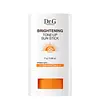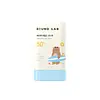What's inside
What's inside
 Key Ingredients
Key Ingredients

 Benefits
Benefits

 Concerns
Concerns

 Ingredients Side-by-side
Ingredients Side-by-side

Zinc Oxide
Cosmetic ColorantButylene Glycol Dicaprylate/Dicaprate
EmollientC12-15 Alkyl Benzoate
AntimicrobialHexyl Laurate
EmollientNeopentyl Glycol Diheptanoate
EmollientOctyldodecanol
EmollientSilica
AbrasiveDibutyl Lauroyl Glutamide
Skin ConditioningPentaerythrityl Tetra-Di-T-Butyl Hydroxyhydrocinnamate
AntioxidantDipentaerythrityl Hexahydroxystearate/Hexastearate/Hexarosinate
Skin ConditioningPolyamide-8
EmollientDibutyl Ethylhexanoyl Glutamide
Skin ConditioningMica
Cosmetic ColorantTitanium Dioxide
Cosmetic ColorantPolyhydroxystearic Acid
EmulsifyingTriethoxycaprylylsilane
Polyglyceryl-4 Isostearate
Emulsifying1,2-Hexanediol
Skin ConditioningNeopentyl Glycol Diethylhexanoate
EmollientEthylhexylglycerin
Skin ConditioningCI 77492
Cosmetic ColorantAluminum Hydroxide
EmollientCI 77491
Cosmetic ColorantCalamine
AbsorbentRuby Powder
Skin ConditioningWater
Skin ConditioningAscorbic Acid
AntioxidantNiacinamide
SmoothingPinus Pinaster Bark Extract
AntioxidantCaesalpinia Spinosa Fruit Extract
Skin ProtectingPanthenol
Skin ConditioningPropanediol
SolventButylene Glycol
HumectantKappaphycus Alvarezii Extract
Skin ConditioningBuddleja Officinalis Flower Extract
UV FilterOenothera Biennis Flower Extract
AstringentPueraria Lobata Root Extract
HumectantPinus Palustris Leaf Extract
TonicUlmus Davidiana Root Extract
Skin ConditioningZinc Oxide, Butylene Glycol Dicaprylate/Dicaprate, C12-15 Alkyl Benzoate, Hexyl Laurate, Neopentyl Glycol Diheptanoate, Octyldodecanol, Silica, Dibutyl Lauroyl Glutamide, Pentaerythrityl Tetra-Di-T-Butyl Hydroxyhydrocinnamate, Dipentaerythrityl Hexahydroxystearate/Hexastearate/Hexarosinate, Polyamide-8, Dibutyl Ethylhexanoyl Glutamide, Mica, Titanium Dioxide, Polyhydroxystearic Acid, Triethoxycaprylylsilane, Polyglyceryl-4 Isostearate, 1,2-Hexanediol, Neopentyl Glycol Diethylhexanoate, Ethylhexylglycerin, CI 77492, Aluminum Hydroxide, CI 77491, Calamine, Ruby Powder, Water, Ascorbic Acid, Niacinamide, Pinus Pinaster Bark Extract, Caesalpinia Spinosa Fruit Extract, Panthenol, Propanediol, Butylene Glycol, Kappaphycus Alvarezii Extract, Buddleja Officinalis Flower Extract, Oenothera Biennis Flower Extract, Pueraria Lobata Root Extract, Pinus Palustris Leaf Extract, Ulmus Davidiana Root Extract
Octyldodecanol
EmollientIsopropyl Palmitate
EmollientButylene Glycol Dicaprylate/Dicaprate
EmollientC12-15 Alkyl Benzoate
AntimicrobialTitanium Dioxide
Cosmetic ColorantBenzotriazolyl Dodecyl P-Cresol
UV AbsorberPolyamide-8
EmollientDibutyl Lauroyl Glutamide
Skin ConditioningSilica Silylate
EmollientDibutyl Ethylhexanoyl Glutamide
Skin ConditioningVinyldimethicone
Aluminum Stearate
Cosmetic ColorantPolyhydroxystearic Acid
EmulsifyingCaprylic/Capric Triglyceride
MaskingAstilbin
AntimicrobialArtemisia Annua Extract
MaskingAscorbic Acid
AntioxidantStearic Acid
CleansingAnthemis Nobilis Flower Oil
MaskingPinus Sylvestris Leaf Oil
MaskingWater
Skin ConditioningPentaerythrityl Tetra-Di-T-Butyl Hydroxyhydrocinnamate
AntioxidantMethylpropanediol
SolventAvena Sativa Kernel Extract
AbrasiveCeramide NP
Skin ConditioningHydrogenated Lecithin
EmulsifyingEctoin
Skin ConditioningDipropylene Glycol
HumectantPanthenol
Skin ConditioningCholesterol
EmollientGlyceryl Stearate
EmollientCeramide AP
Skin ConditioningCeramide Ns
Skin ConditioningCeramide As
Skin ConditioningCeramide EOP
Skin ConditioningOctyldodecanol, Isopropyl Palmitate, Butylene Glycol Dicaprylate/Dicaprate, C12-15 Alkyl Benzoate, Titanium Dioxide, Benzotriazolyl Dodecyl P-Cresol, Polyamide-8, Dibutyl Lauroyl Glutamide, Silica Silylate, Dibutyl Ethylhexanoyl Glutamide, Vinyldimethicone, Aluminum Stearate, Polyhydroxystearic Acid, Caprylic/Capric Triglyceride, Astilbin, Artemisia Annua Extract, Ascorbic Acid, Stearic Acid, Anthemis Nobilis Flower Oil, Pinus Sylvestris Leaf Oil, Water, Pentaerythrityl Tetra-Di-T-Butyl Hydroxyhydrocinnamate, Methylpropanediol, Avena Sativa Kernel Extract, Ceramide NP, Hydrogenated Lecithin, Ectoin, Dipropylene Glycol, Panthenol, Cholesterol, Glyceryl Stearate, Ceramide AP, Ceramide Ns, Ceramide As, Ceramide EOP
Ingredients Explained
These ingredients are found in both products.
Ingredients higher up in an ingredient list are typically present in a larger amount.
Ascorbic Acid is is pure Vitamin C. This form makes up the largest amount of vitamin C found naturally in our skin.
Not only is vitamin C great for your overall health and immune system, it also has plenty of benefits on your skin.
Vitamin C is best used for brightening skin. It improves dark spots, acne scars, and hyperpigmentation. This is because it blocks the process of skin darkening when exposed to UV.
Remember: Vitamin C should not replace sunscreen!
Your skin uses vitamin C to build collagen. Collagen is one key component in having a strong skin barrier and plump skin. Vitamin C also plays a role in regulating collagen, thus making it effective in improving wrinkles and fine lines.
Ascorbic acid shows potent antioxidant activity. As an antioxidant, it helps fight free-radicals. Free-radicals are molecules that may damage your skin cells. These antioxidants also protect skin against UV damage.
The best formulations include Vitamin E and/or ferulic acid. These two ingredients help stabilize and provide a boost in the benefits of ascorbic acid. This is because ascorbic acid becomes unstable when exposed to UV and air. In fact, you can tell your ascorbic acid has oxidized when it turns an orange-yellow color.
Ascorbic acid is generally compatible with other ingredients. However, using ascorbic acid with other active ingredients might cause irritation. Two ingredients: copper ions and benzoyl peroxide, will inactivate ascorbic acid completely.
Read more about other types of Vitamin C:
Foods rich with vitamin C include oranges, strawberries, broccoli, bell peppers, and more. When consuming Vitamin C, your skin receives a portion of the nutrients.
Learn more about Ascorbic AcidWe don't have a description for Butylene Glycol Dicaprylate/Dicaprate yet.
C12-15 Alkyl Benzoate is made up of Benzoic Acid and long chain alcohols. It has a low molecular weight.
C12-15 Alkyl Benzoate is an emollient and texture enhancer. Due to its solubility, it is often used in sunscreens to help evenly distribute active ingredients.
As an emollient, C12-15 Alkyl Benzoate helps soften and hydrate your skin. Emollients create a film on your skin that traps moisture within.
This ingredient has been reported to cause eye irritation.
Learn more about C12-15 Alkyl BenzoateWe don't have a description for Dibutyl Ethylhexanoyl Glutamide yet.
We don't have a description for Dibutyl Lauroyl Glutamide yet.
Octyldodecanol is a fatty alcohol. It is primarily used to enhance the texture of products.
As an emulsifier, Octyldodecanol helps prevent the oils and waters from separating. It also prevents ingredients from creating foam when shaken.
Octyldodecanol is created by reducing fatty acid to an alcohol.
Due to its high molecular weight, it does not get absorbed into the skin.
Learn more about OctyldodecanolPanthenol is a common ingredient that helps hydrate and soothe the skin. It is found naturally in our skin and hair.
There are two forms of panthenol: D and L.
D-panthenol is also known as dexpanthenol. Most cosmetics use dexpanthenol or a mixture of D and L-panthenol.
Panthenol is famous due to its ability to go deeper into the skin's layers. Using this ingredient has numerous pros (and no cons):
Like hyaluronic acid, panthenol is a humectant. Humectants are able to bind and hold large amounts of water to keep skin hydrated.
This ingredient works well for wound healing. It works by increasing tissue in the wound and helps close open wounds.
Once oxidized, panthenol converts to pantothenic acid. Panthothenic acid is found in all living cells.
This ingredient is also referred to as pro-vitamin B5.
Learn more about PanthenolPentaerythrityl Tetra-Di-T-Butyl Hydroxyhydrocinnamate (long name, huh?) is a synthetic antioxidant.
It is used to help stabilize other antioxidants or prevent the color from changing in a product.
As an antioxidant, it helps fight free-radical molecules. Free-radical molecules are capable of damaging our cells and other genetic material. Thus, antioxidants may reduce the signs of aging.
This ingredient is oil-soluble.
Learn more about Pentaerythrityl Tetra-Di-T-Butyl HydroxyhydrocinnamateWe don't have a description for Polyamide-8 yet.
Polyhydroxystearic Acid is a soft wax made from castor oil.
It is is a texture thickener, emulsifier, and film-former. Emulsifiers prevent ingredients from separating, such as oils and waters.
Polyhydroxystearic Acid may not be fungal acne safe.
Learn more about Polyhydroxystearic AcidTitanium dioxide is a mineral UV filter widely used in sunscreens and cosmetics.
It is one of only two UV filters officially classified as “mineral” by regulatory agencies, the other being zinc oxide.
Titanium dioxide provides broad-spectrum protection mostly in the UVB and UVAII range, with some protection in the UVAI range.
While its UVA protection isn’t as strong as zinc oxide’s, the difference is minor.
A common myth is that mineral UV filters reflect UV light. However, modern research shows titanium dioxide absorbs UV radiation like chemical filters (~95% absorption & 5% reflection).
Thanks to its non-irritating nature, titanium dioxide is suitable for sensitive, acne-prone, or redness-prone skin. It is unlikely to cause "eye sting" like other sunscreen ingredients.
A major drawback of this ingredient is its white cast and thick texture. This is why mineral sunscreens often leave a white cast and are less cosmetically elegant than chemical/hybrid sunscreens.
To improve white cast and spreadability, micronized or nano-sized titanium dioxide is often used.
There are ongoing concerns surrounding nano-titanium oxide's impact on marine ecosystems.
There is no conclusive evidence that any form of titanium oxide (or any other sunscreen ingredients) will cause harm to marine ecosystems or coral reefs. The science is still developing but many consumers are keeping a close eye on this issue.
Please note, many destinations have reef-safety sunscreen rules. For instance, the U.S. Virgin Islands advises all visitors to use non-nano mineral sunscreens.
Nano mineral sunscreens once raised safety concerns about absorption into skin.
Extensive research has shown that they do not penetrate healthy or damaged skin; they remain safely on the surface and the top layer of dead skin (stratum corneum).
You'll likely find titanium dioxide bundled with alumina, silica, or dimethicone. These ingredients help make titanium dioxide highly photostable; this prevents it from interacting with other formula components under UV light.
Learn more about Titanium DioxideWater. It's the most common cosmetic ingredient of all. You'll usually see it at the top of ingredient lists, meaning that it makes up the largest part of the product.
So why is it so popular? Water most often acts as a solvent - this means that it helps dissolve other ingredients into the formulation.
You'll also recognize water as that liquid we all need to stay alive. If you see this, drink a glass of water. Stay hydrated!
Learn more about Water